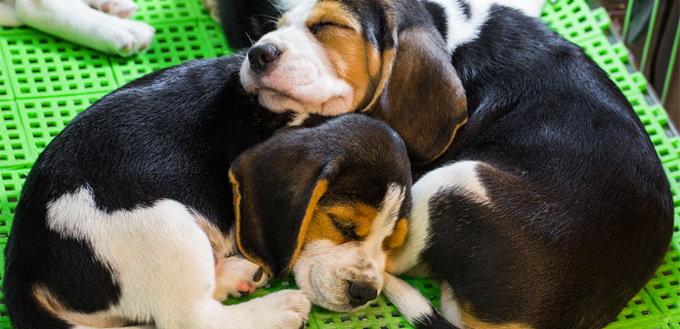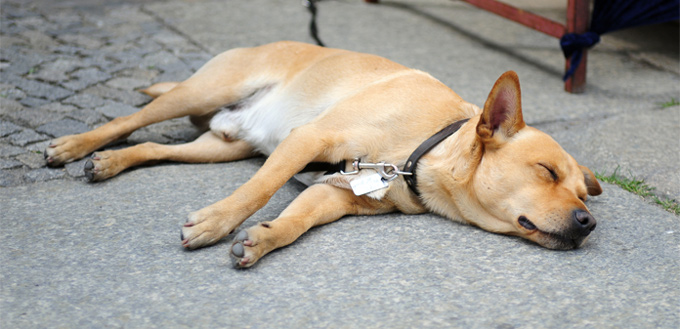You see your dog sleeping soundly on its doggie bed. Then you see the corner of its mouth make that characteristic upward curl as if smiling. But your pet is sound asleep. Could it be that your dog is dreaming? Not only is your dog smiling while its eyes are shut closed. Sometimes, it also makes noises, barks, or whines all while it is in deep slumber. It can even make sudden leg twitching as if kicking something. While it is quite difficult for some folks to think that dogs in these instances are actually dreaming, avid pet parents know with absolute certainty that their hounds are having a dream. And they’re not the only ones who think so.

The Science of Dreaming
The classical interpretation of dreams is strongly rooted in psychoanalytic theory whereby dreams are highly regarded as the reflection of an individual’s mental functioning at the level of the unconscious. However, recent neurophysiologic studies point to a more plausible, more objective understanding of how dreams come about. Neurophysiologic tests point to the role of REM sleep and its interplay with the brainstem in the occurrence of characteristic wave patterns in the brain that are closely associated with a person who is dreaming.
In short, not all scientists today adhere to the conventional explanation of dreams as the result of one’s psychological energies at work. Many of today’s medical practitioners look to brain waves and try to determine what other parts of the brain are actually stimulated and whether this increased in neural activity also extends to other part of the body.
True enough, neurophysiologic studies point to that one very specific stage in sleep – REM or Rapid Eye Movement – to be especially important in the initiation of dreams. It is believed that the brain gets activated or stimulated during the REM stage of sleep, enabling it to anticipate sounds, sights, and all other sensations including emotions that typically occur during the waking state.
Related Post: Washable Dog Beds
What’s this Got to Do with a Dog’s Dream?
The thing to understand here is that REM sleep, in strict evolutionary terms, has also been observed in other members of the animal kingdom especially other mammals and also birds. That being said, while it is true that neurophysiologic REM sleep studies in dogs are not really that as extensive as human studies, here are a few facts that we currently know.
- Dogs have REM stage sleep
A 1977 study on the sleep-wake patterns of pointer breed of dogs showed that these dogs spent about 3 hours or roughly 12 percent of their time in the REM stage of sleep while spending about 10 to 11 hours fully awake and alert within a 24-hour period. While the study did not specifically point to the presence of dreaming in dogs during this particular stage of their sleep, it nevertheless highlights one classic definition of dreams – its coincidence with REM stage sleep.
REM sleep is that stage of sleep where the brain is trying to consolidate various pieces of information including memory, learning experiences, and even negative or bad experiences. This results in the activation or stimulation of a variety of physiologic processes that are characteristic of a fully awake system. This is why dreams are always equated with physiologic responses and not only psychological events.
Dreams are also known to occur in non-REM stages of sleep. However, the dreams that we tend to recall very vividly are those that occur during REM sleep.
The 1977 study did not show, however, that dogs also dream during the REM stage. It would take almost a quarter of a century before advances in neurophysiologic studies in rats will point to the relationship between REM sleep and dreams in the animal kingdom.
- Rats have been proven to dream
Since it would be otherwise unethical of us to subject man’s best friend to tests, there’s no better subject to put our hypotheses for closer scrutiny than laboratory mice or rats. In 2001, a study confirmed that animals, especially mammals and birds, do dream. This was proven when the brain activities of lab rats showed characteristic patterns that resemble the brain wave patterns of humans while they are on a dream state.
What was more interesting was that the same study revealed that the brain waves during the REM sleep episodes of the test subjects closely matched their brain patterns when they were awake and at play. This prompted the investigators to conclude that rats are actually ‘reliving’ their playtime activities in their dreams. The same brain activity was registered in non-REM sleep, albeit shorter in duration.
Related Post: Heated Dog Beds

Dogs Do Dream
The 2001 study by Wilson prompted animal experts to believe that dogs, too, dream. In fact REM sleep is a normal part of the sleep-wake cycle of all warm-blooded mammals as well as birds. Ongoing research also indicates that non-REM sleep is part of the sleep-wake cycle of all vertebrates including a few invertebrates.
These neurophysiologic studies centering on brain activity during both REM and non-REM sleep somehow supported psychoanalytic theories of dream causation. It is now believed that when animals enter a dream state, they are actually processing various information and forming these into memories. No wonder dogs have such exceptional memory recall, too.
Dogs do dream. They go into the REM stage of sleep after about 20 minutes after falling into slumber. Generally, dogs tend to stay in this stage for about 2 to 3 minutes before they move on to deep sleep. It is usually during these 2-3 minutes of REM stage sleep that dog owners may observe their pet to show peculiar behaviors like muscle twitching, irregular breathing, and even vocalization.
One very interesting result of these studies is that the pons – that part of the brain located in the brain stem – is somewhat switched off in certain dogs. The pons is responsible for preventing the contraction of groups of large muscles during sleep so you’ll definitely feel a lot rested. However, because some dogs have either immature pons or that this part of the brain is not actually functioning efficiently, then some of these large muscle groups eventually contract in response to activities in the brain during REM sleep. This has been pointed out as the reason why there is the characteristic muscle twitching in dogs while they are actually deep asleep.
Related Post: Automatic Ball Launcher
What Do Dogs Dream About?
The lab rat studies of 2001 showed that mammals typically relive their ‘awake-stage’ activities in their dreams. Recent studies now show that the reduced functionality of the pons during sleep can actually help dogs ‘act out’ their dreams by removing the restrictions imposed on their muscles. The question everyone is dying to ask is “Now that we know dogs dream, what do they dream about?”
The answer is actually above. The keyword is ‘reliving’ or ‘replaying’ their experiences both as a dog and as a member of your family. Studies suggest that dogs typically ‘dream’ about the things that they have just performed. It is a part of their learning process and memory integration.
The assumption is based on the results of the 2001 studies. If rats are able to show strikingly similar brain wave patterns between REM sleep and awake stages, then it is safe to assume that dogs will have the same response. Their ‘dreams’ will be nothing more than a replay or a reliving of their experiences.
For instance, a pointer that has been out all day searching for that elusive game and pointing to its master the location of the game can actually show the behavior of a running and pointing dog. The same is true with a retriever that has been running to and fro picking up the game in its mouth. So how do scientists know this?
Related Post: Waterproof Dog Beds
Just like the brain wave analysis in rats, scientists were able to compare the brain waves present during the REM sleep of dogs and associate it with the brain waves of various activities during the waking period. For example, if the brain wave pattern seen during REM sleep closely resembles the brain wave pattern of a dog that is running, then it is suggested that the dog is actually dreaming of running.
The most important thing that pet parents should understand is that you play a central role in many of these dreams. For instance, if you’ve been playing Frisbee or playing ball fetch with your dog the whole day, your pet will not only be dreaming about the actual game of ball fetch or Frisbee itself but also relish your presence. And you know what this means? You’re being etched into the mind of your pet. This helps improve and strengthen its relationship with you and further reinforces your pet’s belief that you are indeed its pack leader.
Related Read: Best Dog Frisbee
On the same note, pet owners who can hardly find time to be with their pets may not really play a significant role in their dogs’ dreams.
Dogs do dream. And while they may not be able to verbally share with us the contents of their dreams, we now know that we’re an important part of their dreams – well, that is if we spend enough quality time with them.
Sources:
- Liz Donovan, Do Dogs Dream?, AKC
- Dr. Lynn Buzhardt, Do Dogs Dream?, VCA Hospitals







